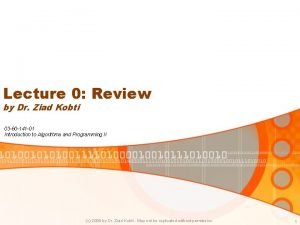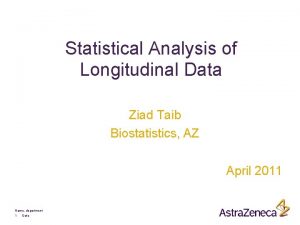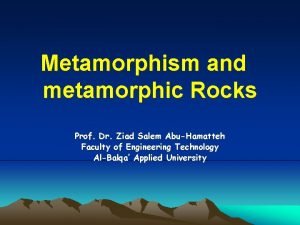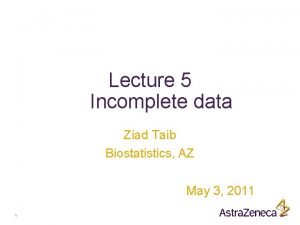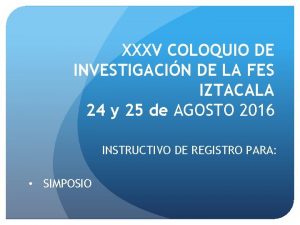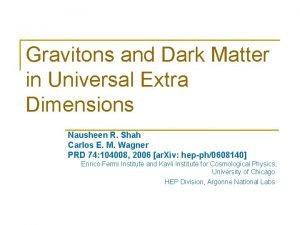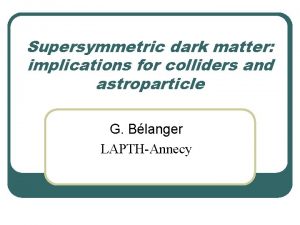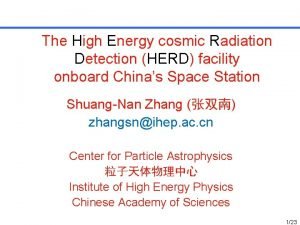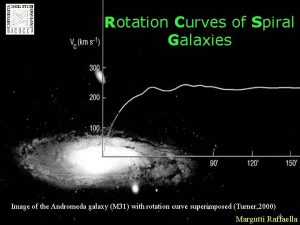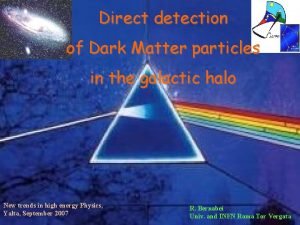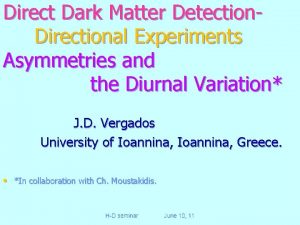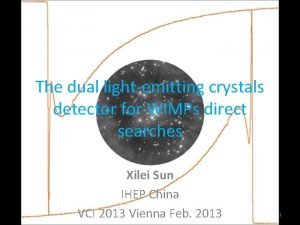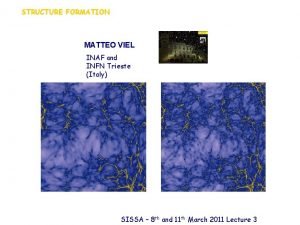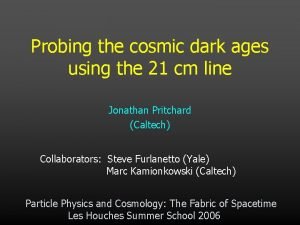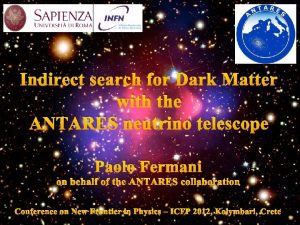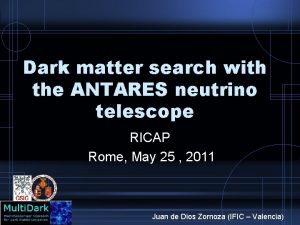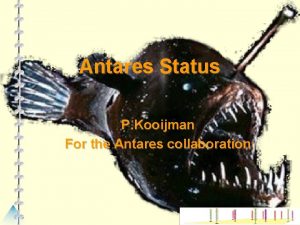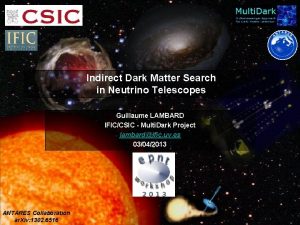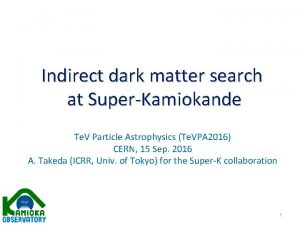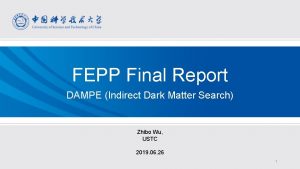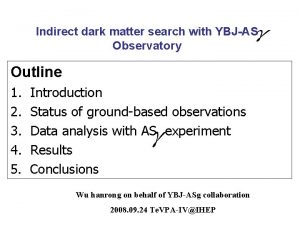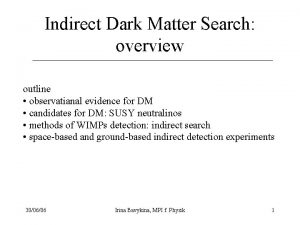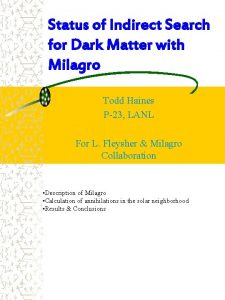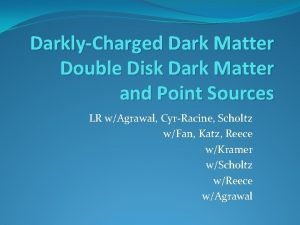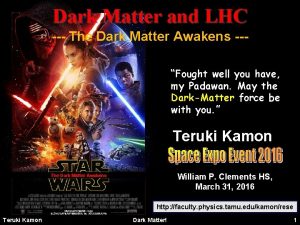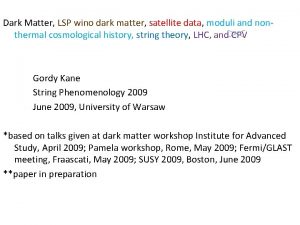Indirect Search For Dark Matter With Antares Ziad





























- Slides: 29

Indirect Search For Dark Matter With Antares Ziad Charif • Supervisor: Paschal Coyle • Co-supervisor: Vincent Bertin • Co-supervisor: Pascal Gay

Outline • • • What’s dark matter? And how we know it exist Neutrino astronomy Searching for dark matter with neutrinos Antares Telescope The analysis Conclusions and final remarks

Dark Matter and the Evidence • • • Rotation curves of spiral galaxies Galaxy groups emitting X-rays Mass to luminosity ratios Velocity dispersion of galaxies Gravitational lensing Other: CMB, BAO, etc.

Possible explanations of DM • Particle Origin: 1. Super-Symmetry LSP 2. Universal Extra Dimensions LKP 3. Axions 4. Sterile neutrinos 5. Etc… • Fields Origin: 1. MOND(MOdified Newtonian Dynamics) 2. Dark fluid 3. From corrections to the conventional gravitational interaction as a result of the reconciliation of gravity with quantum mechanics 4. Etc…

Neutrino Astronomy • Low cross-section messenger • No charge, so no deviation by magnetic fields • Ability to observe the inner workings of the astrophysical objects

Dark matter search via neutrino astronomy • If DM is from a particle origin (LSP or LKP) • Auto-annihilation is possible • Unless the products are stable(photons or electrons), there is always a neutrino • The sun is a very close possible accumulation of DM that can be detected

ANTARES • One of the only few Cherenkov neutrino telescopes in the world (Antares, Baikal, Ice. Cube) • 40 Km offshore, ~2500 m deep, 12 lines, 25 floors per line, with 3 OMs per floor. Totaling a sum of 900 OMs

Event Display: Neutrino-induced muon reconstruction of muon trajectory from time, charge and position of PMT hits assuming relativistic muon emitting Cherenkov light height Example of a reconstructed up-going muon (i. e. a neutrino candidate) detected in 6/12 detector lines: time

And once per year You have to go on detector Shift And search for neutrinos yourself ! oard b r e v Man O

And Then The hunt begins nos! Neutri

And we keep on searching Even during the night ay! w It ran a

Finally A 5 minutes break with the fish and shrimp s? rino t u e n Got

Physics with Antares • • • Neutrino astronomy Neutrino oscillation Diffuse fluxes GRBs Cosmic rays Magnetic monopoles Dark matter Nuclearites K-40 radioactivity Water proprieties

Physics with Antares • • • Neutrino astronomy Neutrino oscillation Diffuse fluxes GRBs Cosmic rays Magnetic monopoles Dark matter Nuclearites K-40 radioactivity Water proprieties

Physics with Antares • • • Neutrino astronomy Neutrino oscillation Diffuse fluxes GRBs Cosmic rays Magnetic monopoles Dark matter Nuclearites K-40 radioactivity Water proprieties

DM Search With Antares • Point source analysis of the Sun and the Galactic center • Anisotropic analysis of the Galactic halo • Dwarf galaxies(high DM/Baryonic mass ratio) • Earth Center

Previous DM results: Search in the Sun Differences between old and new analysis will be highlighted in the next slides

Searching for DM in the sun analysis • Data sample: 2008 data, which is equivalent to 73. 5 of total data life time • Background noise consists of cosmic rays, hitting the earth atmosphere creating muons for down-going events and neutrinos for up-going events • The analysis will mostly focus on eliminating muons that are badly reconstructed as up-going and keeping the neutrinos at the end • A simple track reconstruction algorithm that does not take into account the detector’s dynamic geometry

Event Characteristics Number of floors hit(trigger and reconstruction) Number of detector lines hit A Cherenkov cone like fit estimator A bright point like fit estimator Reconstructed Zenith of the muon Reconstructed Azimuth of the muon Sadly no information on the energy of the neutrino • Etc… • •

Cuts Apply basic cuts: • Events that touch 5 floors or more • Events that touch 2 lines or more • Cut on Zenith, keep up-going events and remove downgoing Then with more complex cuts: • Tchi 2: or quality of reconstruction as a muon generating a Cherenkov cone • Bchi 2: Or quality of reconstructions as a bright point , a characteristic of an electron emitting light • Half Cone angle around the sun, which follows it during our data taking period

Dark Matter and Monte Carlo Background noise: • With a Monte Carlo event generator we simulate our main background noise contributors (and secondary sources), atmospheric neutrinos and muons. And then run them through a simulation of our detector and the same reconstruction algorithm Dark Matter: • With Wimpsim we can generate auto- annihilation of DM particles via model independent process for any DM mass we want, to obtain the differential flux of neutrinos at earth surface

DM Flux and Decay channels • The following masses(Ge. V) of DM were chosen for the analysis: 50, 80. 3, 100, 150, 200, 350, 500, 750, 1000 • Two main decay channels: Hard (τ+τ-), and Soft (b+b-) Linear scale: • 50 Ge. V Hard • 50 Ge. V Soft Log scale: • 1000 Ge. V Hard • 1000 Ge. V Soft

Cut optimization • We use a Model Rejection Factor method based on the Feldman-cousins method of rare events to optimize for best detector sensitivity • This MRF uses a function of three variables, which are the Track fit quality (TChi 2), Bright point fit quality (Bchi 2), and the Half-cone angle. In order to find the exact cut values for the best sensitivity and then apply them on the data set

• • • DATA Muons Atm Neutrinos DM_1 Te. V Hard DM_1 Te. V Soft DM_200 Ge. V Hard TChi 2<1. 4 TCHI 2

• • • DATA Muons Atm Neutrinos DM_1 Te. V Hard DM_1 Te. V Soft DM_200 Ge. V Hard BChi 2>1. 8 BCHI 2

• • • Scrambled DATA Muons Atm Neutrinos DM_1 Te. V Hard DM_1 Te. V Soft DM_200 Ge. V Hard Half-Cone Theta < 6. 1 Degrees

Results Preliminary • • • 2007 Data-Soft 2008 Data-Soft 2007 Data-Hard(W+W- decay channel) 2008 Data-hard(W+W- decay channel 2008 Data-hard(tau+tau- decay channel)

Projection Life time of 3 years

Conclusions And Final Remarks • Same analysis is being finalized with more data, roughly three times the current life time, which should result in around 1. 7 better sensitivity • And can be extended to include the Galactic Center, and Dwarf Galaxies • A parallel analysis using neural networks is in progress, and already showing promising results • Next step will include the switch to PDF’s and estimators instead of the simple binned method, and the use of a dedicated low energy reconstruction to optimize the analysis • Models with higher branching ration in the hard decay channel has more chance of detection
 Dark matter and dark energy presentation
Dark matter and dark energy presentation Dr ziad jaradat
Dr ziad jaradat Aysel şengül ziad jarrah
Aysel şengül ziad jarrah Ziad kobti
Ziad kobti Ziad taib
Ziad taib Alnami
Alnami Dr ziad salem
Dr ziad salem Ziad taib
Ziad taib Cve halluin
Cve halluin Ies antares
Ies antares Antares iztacala correo institucional
Antares iztacala correo institucional How are barnard's star and antares alike
How are barnard's star and antares alike Antares
Antares In a dark dark town
In a dark dark town Matter gravitons dimensions
Matter gravitons dimensions Boosted dark matter
Boosted dark matter Dark matter
Dark matter Calo
Calo Dark matter physics
Dark matter physics Where to stream dark matter
Where to stream dark matter What could dark matter be
What could dark matter be Dark matter
Dark matter Matteo viel
Matteo viel Dark matter
Dark matter Les houches dark matter
Les houches dark matter Classification of matter section 1 composition of matter
Classification of matter section 1 composition of matter Grey matter in nervous system
Grey matter in nervous system Classification of matter section 1 composition of matter
Classification of matter section 1 composition of matter Chapter 2 section 1 classifying matter answer key
Chapter 2 section 1 classifying matter answer key Optic tract
Optic tract



